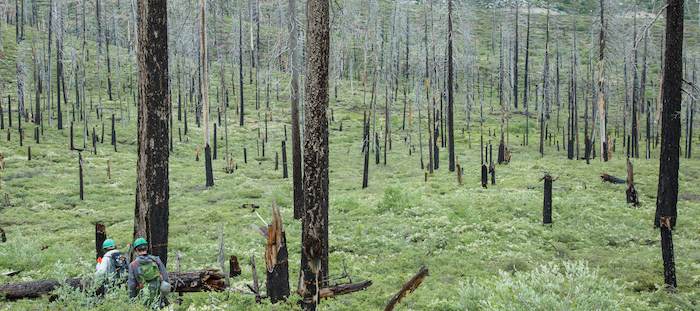
BIRDS AND FIRE

Fire is re-shaping bird habitat in the Sierra Nevada. Climate change and a legacy of long-term fire suppression are yielding bigger, more frequent, and more severe wildfires. These fires may jeopardize bird species that utilize late seral forest, while other species that require recently killed trees or other post-fire habitat elements may thrive. But even ‘fire-loving’ bird species may face challenges due to potentially novel post-fire habitat conditions and efforts to harvest or manage burned forests.
IBP partners with the US Forest Service, the National Park Service, and other land managers throughout the Sierra Nevada to study how birds are responding to habitat changes resulting from fire – and to forest management efforts intended to reduce fire risk or restore forest after fire. Much of our work focuses on species of conservation concern in the region, like Black-backed Woodpecker, California Spotted Owl, Great Gray Owl, and Northern Goshawk. The main goal of all this work is to make fire and forest management more compatible with bird conservation.
The video below about our Black-backed Woodpecker work was produced by the U.S. Forest Service as part of a series on habitat restoration of National Forests in California.
This video about IBP’s Black-backed Woodpecker research was produced by the U.S. Forest Service as part of a series on habitat restoration of National Forests in California.
In addition to studying the effects of fire on species of current management concern, we are also studying how the changing fire regime is affecting the broader bird community, and developing insights for land and forest management that sustains and maximizes avian biodiversity in this time of rapid ecological change.
For more information about our work to study and conserve birds that may be jeopardized by fire or depend on fire, contact Rodney Siegel.
Photo Credits: Top of left panel, Jean Hall; bottom of right panel, Keg River.
BLACK-BACKED WOODPECKERS
IBP's research on Black-backed Woodpeckers and fire is informing land management actions on National Forest land across California’s Sierra Nevada. The woodpeckers are known to be burned forest specialists, but IBP research has recently revealed the picture to be more complicated – the birds need "pyrodiversity" or a diversity in age, size and severity of burned patches. Recent research by our team shows that young birds preferentially use live trees for cover during the early weeks after fledging, and their parents preferentially nest in patches of severely burned forest that have live trees nearby. These findings are upending conventional thinking about which areas within burned forests are most important to retain as habitat.
.jpg)
SELECTED PUBLICATIONS
Peer-reviewed Publications Authored by IBP Personnel
Herring, G., L.B. Tennant, J.J. Willacker, M. Johnson, R.B. Siegel, J.S. Polasik, and C.A. Eagles-Smith. 2024. Wildfire burn severity and stream chemistry influence aquatic invertebrate and riparian avian mercury exposure in forested ecosystems. Ecotoxicology 33:1. PDF
Stillman, A.N., R.L. Wilkerson, D.R. Kaschube, R.B. Siegel, S.C. Sawyer, and M.W. Tingley. 2023. Incorporating pyrodiversity into wildlife habitat assessments for rapid post-fire management: a woodpecker case study. Ecological Applications 2023:e2853. PDF
Tingley, M.W., G.A. Montgomery, R.L. Wilkerson, D.R. Cluck, S.C. Sawyer, and R.B. Siegel. 2023. Multi-trophic occupancy modeling connects temporal dynamics of woodpeckers and beetle sign following fire. PLoS ONE 18:e0281687. PDF
Siegel, R. and R. Wilkerson. 2022. A giant loss: losing sequoias could be a blow to Sierra Nevada Birds. The Wildlife Professional 16:54-55. PDF
Loverin, J.K., A.N. Stillman, R.B. Siegel, R.L. Wilkerson, M. Johnson, and M.W. Tingley. 2021. Nestling provisioning behavior of Black-backed Woodpeckers in post-fire forest. The Journal of Field Ornithology 92:273-283. PDF
Stillman, A.N., T.J. Lorenz, P.C. Fischer, R.B. Siegel, R.B., R.L. Wilkerson, M. Johnson, and M.W. Tingley. 2021. Juvenile survival of a burned forest specialist in response to variation in fire characteristics. Journal of Animal Ecology 90:1317-1327. PDF
Stillman, A.N., T.J. Lorenz, R.B. Siegel, R.L. Wilkerson, M. Johnson, and M.W. Tingley. 2021. Conditional natal dispersal provides a mechanism for populations tracking resource pulses after fire. Behavioral Ecology 2021:1-10. PDF
Ray, C., D.R. Cluck, R.L. Wilkerson, R.B. Siegel, A.M. White, G.L. Tarbill, S.C. Sawyer, and C.A. Howell. 2020. Chapter 9 - Woodboring beetle colonization of conifers killed by fire and bark beetles: implications for forest restoration and Black-backed Woodpecker conservation. Pages 179-186 in: K.M.Potter and B.L. Conkling, eds. Forest health monitoring: national status, trends, and analysis 2019. U.S.D.A. Forest Service General Technical Report SRS-250. PDF
Tingley, M.W., A.W. Stillman, R.L. Wilkerson, S.C. Sawyer, and R.B. Siegel. 2020. Black-backed woodpecker occupancy in burned and beetle-killed forests: disturbance agent matters. Forest Ecology and Management 455:117694. PDF
Tingley, M.W., C.P. Nadeau, and M.E. Sandor. 2020. Multi‐species occupancy models as robust estimators of community richness. Methods in Ecology and Evolution 11:633-642. For a copy of this publication, please contact Morgan Tingley.
Ray, C., D.R. Cluck, R.L. Wilkerson, R.B. Siegel, A.M. White, G.L. Tarbill, S.C. Sawyer, and C.A. Howell. 2019. Patterns of woodboring beetle activity following fires and bark beetle outbreaks in montane forests of California, USA. Fire Ecology 15:21. PDF
Siegel, R.B., S.A. Eyes, M.W. Tingley, J.X. Wu, S.L. Stock, J.R. Medley, R.S. Kalinowski, A. Casas, M. Lima-Baumbach, and A.C. Rich. 2019. Short-term resilience of Great Gray Owls to a megafire in California, USA. The Condor: Ornithological Applications 121:1-13. For a copy of this publication, please contact Rodney Siegel.
Stillman, A.N., R.B. Siegel, R.L. Wilkerson, M. Johnson, and M.W. Tingley. 2019. Age-dependent habitat relationships of a burned forest specialist emphasise the role of pyrodiversity in fire management. Journal of Applied Ecology 56:880-890. PDF
Stillman, A.N., R.B. Siegel, R.L. Wilkerson, M. Johnson, C.A. Howell, and M.W. Tingley. 2019. Nest site selection and nest survival of Black-backed Woodpeckers after wildfire. The Condor: Ornithological Applications 121(3). PDF
White, A.M., G.L. Tarbill, B. Wilkerson, and R. Siegel. 2019. Few detections of Black-backed Woodpeckers (Picoides arcticus) in extreme wildfires in the Sierra Nevada. Avian Conservation and Ecology 14:17. PDF
Stillman, A.N., and F. Tousley. 2018. Novel function of flutter display in the Black-backed Woodpecker. Western Birds 49:149–151. PDF
Tingley, M.W., A.N. Stillman, R.L. Wilkerson, C.A. Howell, S.C. Sawyer, and R.B. Siegel. 2018. Cross-scale occupancy dynamics of a postfire specialist in response to variation across a fire regime. The Journal of Animal Ecology 00:1-13. For a copy of this publication, please contact Rodney Siegel.
Casas, A., M. Garcia, R.B. Siegel, C. Ramirez, A. Koltunov, and S.L. Ustin. 2016. Burned forest characterization at single-tree level with Airborne Laser Scanning for wildlife habitat assessment. Remote Sensing of Environment 175:231-241. PDF
Siegel, R.B., M.W. Tingley, R.L. Wilkerson, C.A. Howell, M. Johnson, and P. Pyle. 2016. Age structure of Black-backed Woodpecker populations in burned forests. The Auk: Ornithological Advances 133:69-78. PDF
Tingley, M.W., R.L. Wilkerson, C.A. Howell, and R.B. Siegel. 2016. An integrated occupancy and home-range model to predict abundance of a wide-ranging, territorial vertebrate. Methods in Ecology and Evolution 7:508-517. PDF
Tingley, M.W., V. Ruiz-Gutiérrez, R.L. Wilkerson, C.A. Howell, and R.B. Siegel. 2016. Pyrodiversity promotes avian diversity over the decade following forest fire. Proceedings of the Royal Society B 283:20161703. (For a copy of this publication, please contact Rodney Siegel.)
Siegel, R.B., R.L. Wilkerson, M.W. Tingley, and C.A. Howell. 2014. Roost sites of the Black-backed Woodpecker in burned forest. Western Birds 45:296-303. PDF
Tingley, M.W., R.L. Wilkerson, M.L. Bond, C.A. Howell, and R.B. Siegel. 2014. Variation in home range size of Black-backed Woodpeckers (Picoides arcticus). The Condor: Ornithological Applications 116:325-340. PDF
Bond, M.L., R.B. Siegel, R.L. Hutto, V. Saab, and S. Shunk. 2012. A new forest fire paradigm: the need for high-severity fires. The Wildlife Professional 6:46-49. PDF
Siegel, R.B., M.L. Bond, R.L. Wilkerson, B.C. Barr, C. Gardiner, and J.M. Kinsella. 2012. Lethal Procyrnea nematode infection in a Black-backed Woodpecker (Picoides arcticus) from California. The Journal of Zoo and Wildlife Medicine 43:421-424. PDF
Saracco, J.F., R.B. Siegel, and R.L. Wilkerson. 2011. Occupancy modeling of Black-backed Woodpeckers on burned Sierra Nevada forests. Ecosphere 2:art31. PDF
Peer-reviewed Publications by Other Researchers
Kelly. L.T., and L. Brotons. 2017. Using fire to promote biodiversity. Science 355:1264-1265. PDF
Other Publications and Reports
Siegel, R.B., M.W. Tingley, and R.L. Wilkerson. 2022. Black-backed Woodpecker MIS surveys on Sierra Nevada national forests: 2021 annual report. The Institute for Bird Populations, Petaluma, CA. PDF
Siegel, R.B., M.W. Tingley, and R.L. Wilkerson. 2020. Black-backed Woodpecker MIS Surveys on Sierra Nevada national forests: 2019 Annual Report. The Institute for Bird Populations. PDF
Siegel, R.B., M.W. Tingley, and R.L. Wilkerson. 2019. Black-backed Woodpecker MIS surveys on Sierra Nevada national forests: 2018 annual report. The Institute for Bird Populations. Point Reyes Station, CA. PDF
Siegel, R.B., M.L. Bond, C.A. Howell, S.C. Sawyer, and, D.L. Craig, editors. 2018. A Conservation Strategy for the Black-backed Woodpecker (Picoides arcticus) in California. Version 2.0. The Institute for Bird Populations and California Partners in Flight. Point Reyes Station, California. PDF
Siegel, R.B., M.W. Tingley, and R.L. Wilkerson. 2018. Black-backed Woodpecker MIS surveys on Sierra Nevada national forests: 2017 annual report. Report to U.S.D.A. Forest Service Pacific Southwest Region. The Institute for Bird Populations, Point Reyes Station, CA. PDF
Siegel, R.B., M.W. Tingley, and R.L. Wilkerson. 2017. Black-backed Woodpecker MIS surveys on Sierra Nevada national forests: 2016 annual report. Report to U.S.D.A. Forest Service Pacific Southwest Region. The Institute for Bird Populations, Point Reyes Station, CA. PDF
Schofield, L.N., R.B. Siegel, J.X. Wu, and R.L. Wilkerson. 2016. Avian monitoring in the King Fire: surveying Black-backed Woodpeckers during the 2015 breeding season. Report to the US Forest Service, El Dorado National Forest. The Institute for Bird Populations, Point Reyes Station, CA.
Siegel, R.B., M.W. Tingley, and R.L. Wilkerson. 2016. Black-backed Woodpecker MIS surveys on Sierra Nevada national forests: 2015 annual report. Report to U.S.D.A. Forest Service Pacific Southwest Region. The Institute for Bird Populations, Point Reyes Station, CA. PDF
Polasik, J.S. 2015. Annotated bibliography of recently published literature on the Black-backed Woodpecker. The Institute for Bird Populations, Point Reyes Station, CA. PDF
Siegel, R.B., M.W. Tingley, and R.L. Wilkerson. 2015. Black-backed Woodpecker MIS surveys on Sierra Nevada national forests: 2014 annual report. Report to U.S.D.A. Forest Service Pacific Southwest Region. The Institute for Bird Populations, Point Reyes Station, CA. PDF
Tingley, M.W, R.L. Wilkerson, and R.B. Siegel. 2015. Explanation and guidance for a decision support tool to help manage post-fire Black-backed Woodpecker habitat. The Institute for Bird Populations, Point Reyes Station, California. PDF
Siegel, R.B., M.W. Tingley, and R.L. Wilkerson. 2014. Assessing home-range size and habitat needs of Black-backed Woodpeckers in California: report for the 2013 field season. Report to U.S.D.A. Forest Service Pacific Southwest Region. The Institute for Bird Populations, Point Reyes Station, CA. PDF
Siegel, R.B., M.W. Tingley, and R.L. Wilkerson. 2014. Black-backed Woodpecker MIS surveys on Sierra Nevada national forests: 2012 annual report. The Institute for Bird Populations, Point Reyes Station, CA. PDF
Siegel, R.B., M.W. Tingley, and R.L. Wilkerson. 2014. Black-backed Woodpecker MIS surveys on Sierra Nevada national forests: 2013 annual report. Report to U.S.D.A. Forest Service Pacific Southwest Region. The Institute for Bird Populations, Point Reyes Station, CA. PDF
Siegel, R.B., M.W. Tingley, and R.L. Wilkerson. 2013. Black-backed Woodpecker MIS surveys on Sierra Nevada national forests: 2012 annual report. The Institute for Bird Populations, Point Reyes Station, CA.
Siegel, R.B., M.W. Tingley, R.L. Wilkerson, and M.L. Bond. 2012. Assessing home range size and habitat needs of Black-backed Woodpeckers in California: report for the 2011 and 2012 field seasons. Report to U.S.D.A. Forest Service Pacific Southwest Region. The Institute for Bird Populations, Point Reyes Station, CA. PDF
Bond, M.L., R.B. Siegel, and D. Craig, editors. 2012. A conservation strategy for Black-backed Woodpecker (Picoides arcticus) in California. The Institute for Bird Populations and California Partners in Flight. PDF
Siegel, R.B., M.W. Tingley, and R.L. Wilkerson. 2012. Black-backed Woodpecker MIS surveys on Sierra Nevada national forests: 2011 annual report. Report to U.S.D.A. Forest Service Pacific Southwest Region. The Institute for Bird Populations, Point Reyes Station, CA. PDF
Siegel, R.B., M.W. Tingley, and R.L. Wilkerson. 2011. Black-backed Woodpecker MIS surveys on Sierra Nevada national forests: 2010 annual report. Report to U.S.D.A. Forest Service Pacific Southwest Region. The Institute for Bird Populations, Point Reyes Station, CA. PDF
Siegel, R.B., J.F. Saracco, and R.L. Wilkerson. 2010. Management indicator species (MIS) surveys on Sierra Nevada national forests: Black-backed Woodpecker. 2009 annual report. Report to U.S.D.A. Forest Service Pacific Southwest Region. The Institute for Bird Populations, Point Reyes Station, CA. PDF
Siegel, R.B., R.L. Wilkerson, and D.L. Mauer. 2008. Black-backed Woodpecker (Picoides arcticus) surveys on Sierra Nevada national forests: 2008 pilot study. Report to Region 5 of the U.S.D.A. Forest Service. The Institute for Bird Populations, Point Reyes Station, CA. PDF








